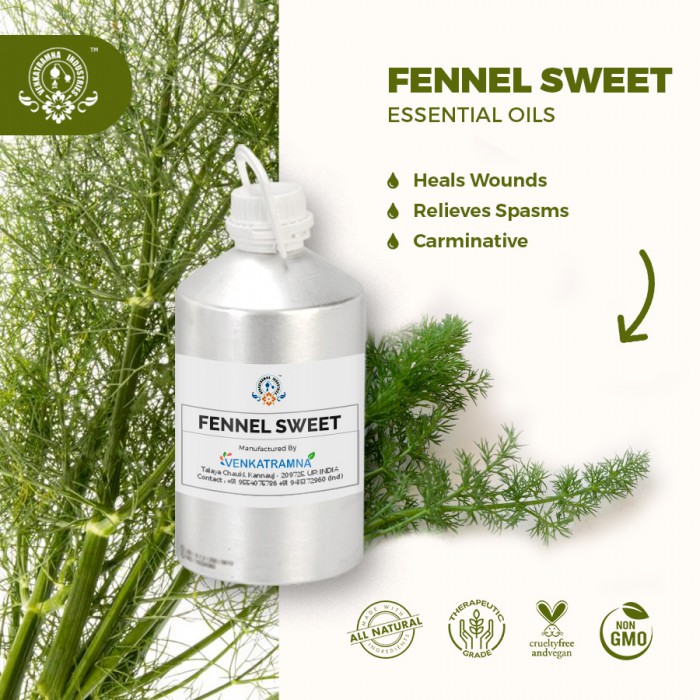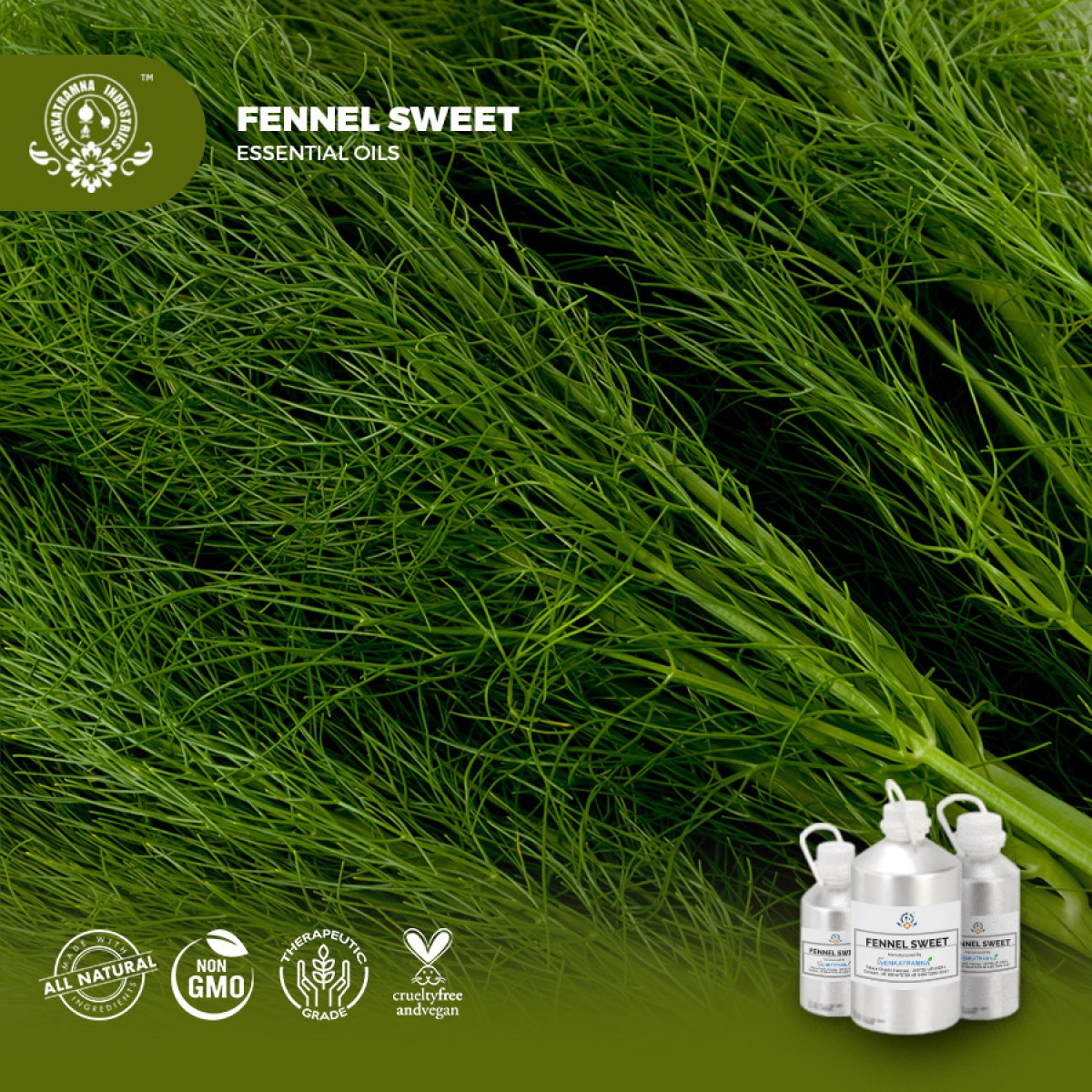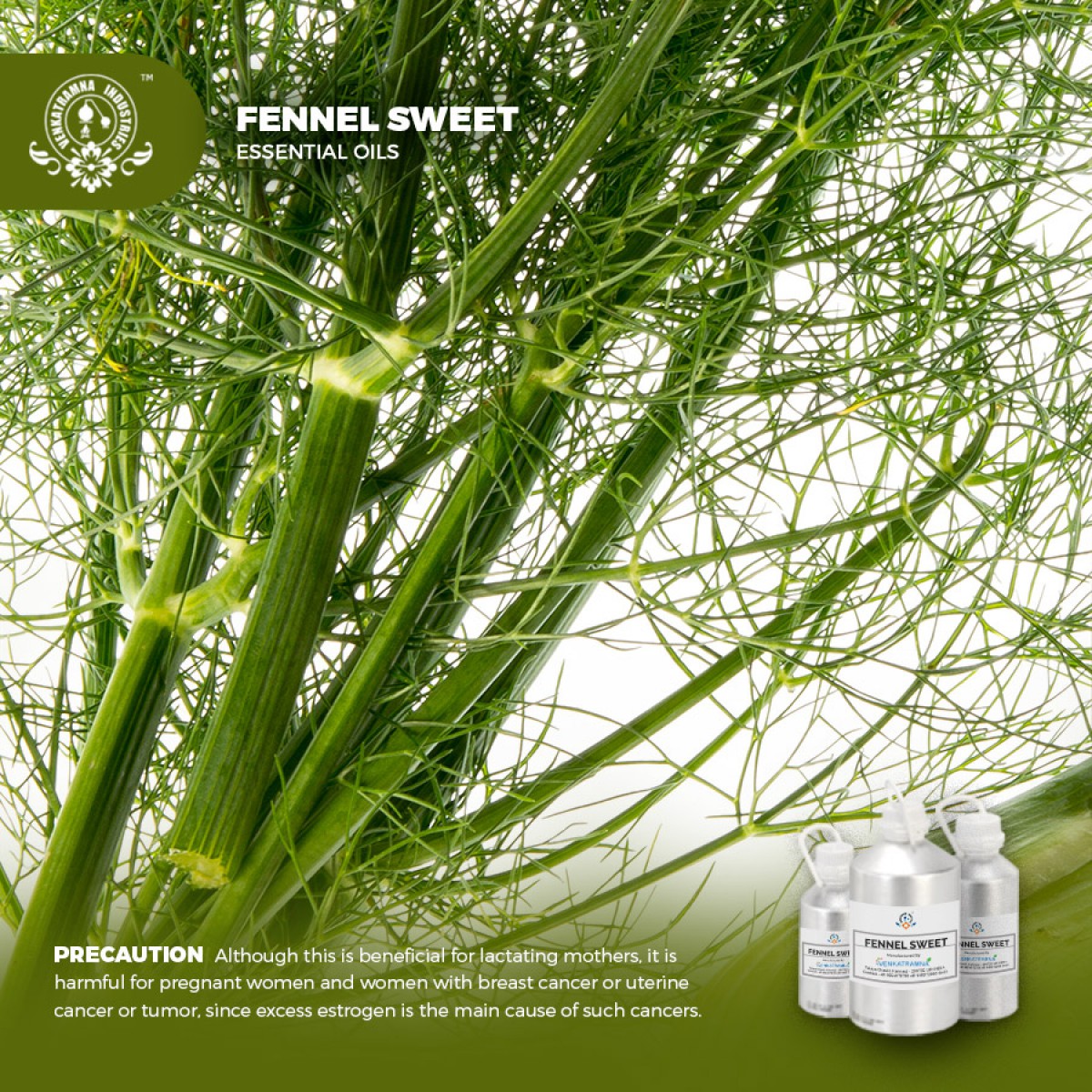Botanical Name: Foeniculum vulgare Common name: Moti saunf, Saunf, Fennel, Sweet fe Read More
|
Botanical
Name: |
Foeniculum vulgare |
|
Common name: |
Moti saunf, Saunf, Fennel, Sweet fennel, Florence fennel,
Finocchio |
|
Plant family: |
Apiaceae |
|
Genus: |
Foeniculum |
|
Appearance/Color: |
Clear to pale yellow liquid. |
|
Odor: |
A top note with a medium aroma, Fennel Sweet Essential Oil has a
similar to that of black licorice. |
|
Blends With: |
Bergamot, Lavender, Frankincense and Rose. |
|
Origin: |
Hungry |
|
Source: |
Seed |
|
Method of
Extraction: |
Steam Distillation |
Foeniculum vulgare, called
common fennel, is an upright, branching perennial that is typically grown in
vegetable and herb gardens for its anise-flavored foliage and seeds, both of
which are commonly harvested for use in cooking. It somewhat resembles a very
large dill plant. It grows to 3-5’ (less frequently to 6’) tall and features
feathery, compound, aromatic, yellow-green leaves with needle-like segments and
tiny yellow flowers in large, flattened, compound umbels. Flowers bloom in mid-
to late summer, and are followed by aromatic seeds. Plants have escaped gardens
and naturalized in many parts of North America. Flowers are very attractive to
butterflies. Fennel is a larval plant for certain swallowtail butterflies.
Foeniculum vulgare Mill. is a biennial medicinal and aromatic plant belonging to the family Apiaceae (Umbelliferaceae). It is a hardy, perennial–umbelliferous herb with yellow flowers and feathery leaves. It grows to a height of up to 2.5 m with hollow stems. The leaves grow up to 40 cm long; they are finely dissected with the ultimate segments filiform (thread like) of about 0.5 mm wide. The flowers are produced in terminal compound umbels. The fruit is a dry seed 4–10 mm long. It is generally considered indigenous to the shores of Mediterranean Sea but has become widely naturalized in many parts of the world especially on dry soils near the sea coast and on the river banks. Some authors distinguish two sub-species of fennel, piperitum and vulgare: sub-species piperitum has bitter seeds, while sub-species vulgare has sweet seeds which are used as flavoring agents in baked goods, meat and fish dishes, ice creams, alcoholic beverages etc, due to their characteristic anise odor. Morphological differences between these two sub-species are not always clearly defined.
DISCLAIMER
The complete range of conditions
or methods of use are beyond our control therefore we do not assume any
responsibility and expressly disclaim any liability for any use of this
product. Information contained herein is believed to be true and accurate however,
all statements or suggestions are made without warranty, expressed or implied,
regarding accuracy of the information, the hazards connected with the use of
the material or the results to be obtained from the use thereof. Compliance
with all applicable federal, state, and local laws and local regulations
remains the responsibility of the user.
The FDA has not evaluated the
statements on this website. No claims are made by Venkatramna Industries as to
the medicinal value of any products from vriaroma.com or by us. The information
presented here is for educating our customers about the traditional uses of
essential oils and is not intended to diagnose, treat, cure, or prevent any
disease. You are responsible for understanding the safe application of these products.
If you have any questions, please call or email us for further information.
As per NAHA guidelines, New Directions Aromatics
(NDA) does not recommend the ingestion of essential oils. It is imperative to
consult a medical practitioner before using Essential Oils for therapeutic
purposes. Pregnant and nursing women and those taking prescription drugs are
especially advised not to use this product without the medical advice of a
physician. The oil should always be stored in an area that is inaccessible to
children, especially those under the age of 7.
Foeniculum vulgare (Apiaceae)
commonly known as fennel is a well-known and important medicinal and aromatic
plant widely used as carminative, digestive, lactogogue
and diuretic and in treating respiratory and gastrointestinal
disorders. Its seeds are used as flavorings in baked goods, meat and fish
dishes, ice cream, alcoholic beverages and herb mixtures.
Fennel Sweet Essential Oil in
Pharma
Fennel has been used in
traditional medicine to treat various diseases for thousands of years in the
East Asian countries, India and China. People have long been familiar with
fennel plant. In the middle ages people believed that chewing the seeds is
important to eliminate abdomen noise. In the fifth century it was believed that
fennel had sedative effect and in 9th to 14th centuries numerous therapeutic
properties were attributed to it. The Romans believed that fennel seed could
help supercharge the vision. The English believed that the plant could offer
relief from bloating stomach and facilitate digestion. The fennel therapeutic
use has been serious since the 18th century, and many studies have been taken.
Nowadays, the different parts of the plant are used in treatment of many
diseases, particularly pain in the digestive system. Also, it is very useful in
the treatment of diabetes, bronchitis, chronic cough and kidney stones
Essence of Fennel Sweet
Essential Oil
It is a highly aromatic and
flavorful herb with culinary and medicinal uses. Fennel seeds are anise like in
aroma and are used as flavorings in baked goods, meat and fish dishes, ice
cream, alcoholic beverages and herb mixtures. The bulb, foliage and seeds of
the fennel plant are widely used in many of the culinary traditions of the
world. Dried fennel seed is an aromatic, anise-flavored spice, brown or green
in color when fresh, slowly turning a dull grey as the seed ages. For cooking
green seeds are the best. The bulb is a crisp, hardy root vegetable and may be
sautéed, stewed, braised, grilled or eaten raw. Fennel features predominantly
in Mediterranean cuisine, where bulbs and fronds are used, both raw and cooked,
in side dishes, salads, pastas, vegetable dishes. Many cultures in the Indian
subcontinent and the Middle East use fennel seeds in their cooking. Fennel is
one of the most important spices in Kashmiri Pandit and Gujarati cooking.
COMMON USAGE
·
Heals wounds
·
Relieves spasma
·
Smoothens bowel movements
·
Carminative
·
Kills worms
·
Stimulates urination
·
Emmenagogue
·
Promotes lactation
·
Laxative
·
Acts as stimulant
·
Keeps stomach healthy
·
Healthy spleen
·
Tonic effect
·
Purifies the blood
·
Treats chronic cough
·
Antibacterial and Antifungal
·
Anti-inflammatory
Ingredients:
|
S. No |
Key Constituents |
Strength (%) |
|
1 |
(E)-anethole |
58.1-92.5 |
|
2 |
(P)- limonene |
0.2-21.0 |
|
3 |
fenchone |
0.2-8.0 |
|
4 |
Estragole |
1.1-4.8 |
|
5 |
a-pinene |
0.1-3.4 |
|
6 |
a-phellandrene |
0.1-2.0 |
|
7 |
(z)-anethole tr |
0.7 |
TOXICOLOGICAL
INFORMATION
Safety Summary
·
Hazards Drug interaction; reproductive
hormone modulation; potentially carcinogenic, based on estragole content; may
inhibit blood clotting; skin sensitization if oxidized.
·
Contraindications (all routes):
Pregnancy, breastfeeding, endometriosis, estrogen-dependent cancers, children
under five years of age.
·
Cautions (oral): Diabetes medication,
anticoagulant medication, major surgery, peptic ulcer, hemophilia, other
bleeding disorders.
·
Maximum adult daily oral dose 54 mg
Organ-specific effects
·
Adverse skin reactions: Undiluted bitter
fennel oil was nonphototoxic in hairless mice and swine. The undiluted oil was
irritating to rabbits, but was not irritating to mice or pigs; tested at 4% on
two panels of 25 volunteers it was not irritating
·
Cardiovascular effects: (E)-anethole
inhibits platelet aggregation an essential step in the blood clotting cascade.
Sweet fennel oil reduced blood glucose levels in both normal and
alloxan-diabetic rats following sc injection at 21.5 mg/kg.
·
Hepatotoxicity: (E)-Anethole has a
dose-dependent hepatotoxicity which is due to a metabolite, anethole
10,20-epoxide (AE) and different amounts of AE are produced in different
species. High doses of (E)-anethole or AE deplete glutathione but sweet fennel
oil, which has a very similar composition to bitter fennel, significantly
induced glutathione S-transferase activity in mouse tissues. The amounts of
(E)-anethole-rich essential oils used in aromatherapy pose no risk to humans.
Systemic effects
·
Acute toxicity: Bitter fennel acute oral
LD50 in rats 4.52 mL/kg; acute dermal LD50 in rabbits >5 g/kg.
·
Carcinogenic/anticarcinogenic potential:
No information found for bitter fennel oil. Estragole is a rodent carcinogen
·
Serious eye damage / irritation: Not
classified.
·
Germ Cell Mutagenicity: Not classified.
·
Carcinogenicity: Not classified.
·
Reproductive toxicity: Not classified.
·
STOT-single exposure: Not classified.
·
STOT-repeated exposure: Not classified.
·
Aspiration hazard: May be fatal if
swallowed and enters airways.
·
Photo-toxicity: No additional data
available.
ECOLOGICAL
INFORMATION
·
Toxicity: Not Determined
·
Persistence & degradability
Biodegradability: no degradability data is available; the substance is
considered as not degrading quickly.
·
Bioaccumulation Potential: No additional data
available.
·
Mobility in soil: No additional data available.
·
Results of PBT and vPvB Assessment: No
additional data available.





 MSDS-Fennel1.pdf
MSDS-Fennel1.pdf




